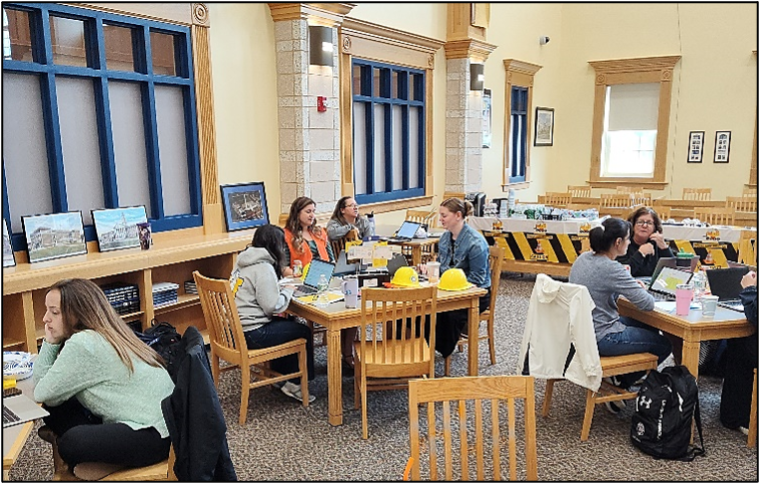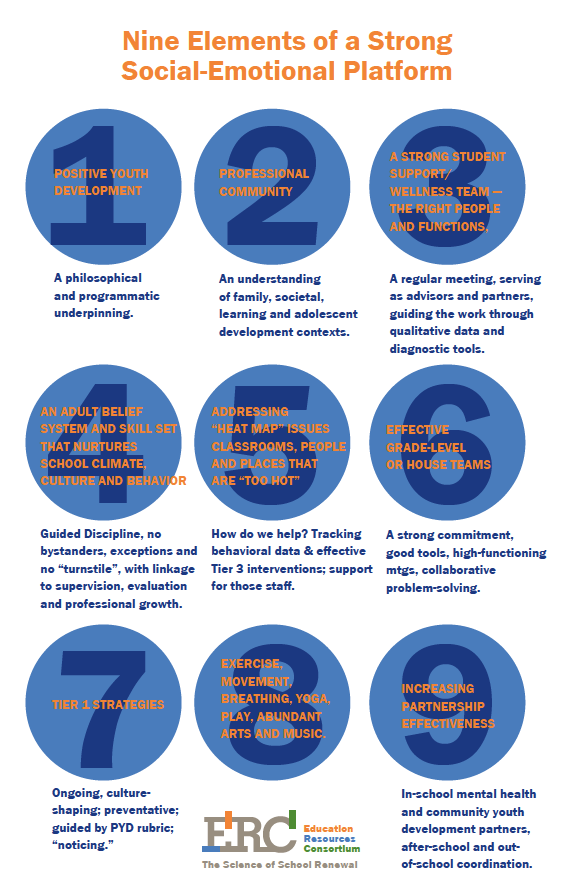Welcome to Volume 5 of our EdHistory 101 Project, our periodic revisiting of key historical events, personalities, and perspectives that continue to shape our ideas of school. Knowing our nation’s educational history—the forces, beliefs, and language of other times—presents opportunities for us to reconsider the roles we need school to play for the social and intellectual well-being of our young people. It’s a way for us to assess the prevailing values, to re-frame our work and, with persistence, to re-imagine the systems, culture, and practices that cement the grammar of schooling.
Larry Myatt, Co-Founder, ERC
With the hindsight available to us we can look back
on the No Child Left Behind Education Act (2001) as the folly it has been, ill-conceived and impossible to realize, confirming what so many had predicted but nevertheless a legislation whose elements overpowered a vulnerable sector.
But we seldom bother to look back at the many hard-won fruits of the decade preceding it, 1990- 2000, a time of energetic, collaborative discovery, of new and big thinking. Those thinking and writing about schools and learning in the 1990’s were many – Ted Sizer, James Comer, Fred Newmann, John Goodlad, Elliot Eisner, Mortimer Adler, Henry Levin, Ernest Boyer, Roland Barth, Linda Darling-Hammond, Jerome Bruner, Edmund Gordon, Grant Wiggins, Vito Perrone, Thomas Sergiovanni, Herb Kohl, Art Powell, Deborah Meier, David Tyack, Paul Hill, Pat Carini, Robert Evans, Gerald Bracey, bell hooks, Michael Fullan, and so many more. Yet, how many of us can remember the Coalition of Essential Schools, CORS at UWisconsin, the roots of Project Zero, Comer’s School Development Project, the Accelerated Schools Project, or the fleeting but provocative ATLAS Schools Project? It was a time of major investment from both private and public sectors, with thoughtful innovation and exceptional collaboration paired with a belief in the power and integrity of education’s own intellectual establishment.
But No Child, like the comet Chicxulub that hit the Yucatan and led to the demise of so many species, it dissolved much of that era’s history and knowledge. So much of that era’s lore has disappeared from contemporary conversations about today’s schooling, and a new generation of educators may not realize the price that has been paid.
This volume of EdHistory 101 then seeks to bring back some powerful observations from the Yale psychologist Seymour Sarason who saw the insides of “school” so clearly, who perhaps diagnosed those inner workings better than anyone before or since . His insights remain as true these days as during that golden era. We can only share a select few and suggest digging into this rather vast realm of books and studies. Enjoy!
Seymour Sarason wrote a lot, and about many different topics. A brilliant psychologist, he brought a unique lens to understanding schools. He deemed it an “ecological approach”, one which necessarily includes consideration of one’s surroundings, routines, conversations, upbringing, values and conversations, as free as possible from the biases and opinions of the observer(s). His thinking on the preparation of teachers and leaders has few parallels.
Asked in the late-80s and early-90s to bring his observational powers to the quest for “school reform”, he spent many of his latter professional years thinking and writing about how schools might be understood in a deeper way to inform the changes being imposed on them. He was less and less subtle in his critique of the top-down approach beginning to reveal itself, warning against heavy-handedness and the use of limited data to guide “school reform”. He let his insights and studies speak for themselves. What follows are three of his observations that should be taken to heart by today’s educators and policy makers.
1- The Classroom as Preparation for the Principal’s Office
As Sarason noted, its exceedingly rare for a person to become a principal without first having been a teacher for a number of years. The idea being that unless a principal has had long experience in teaching and managing children in a classroom, she/he cannot understand teachers and cannot therefor, offer much help. It was/is an idea he noted had some merit, but fell short in pursuing other considerations, four in particular:
Years spent in a classroom with children is no compelling basis for assuming it prepares one for a position in which one’s major task is working with adults. Being a leader of children, he posed, does not necessarily prepare one for being a leader of adults.
Teachers who are autonomous in their classrooms, have relatively little to do with each other in daily professional life. They may have feelings of loyalty to the school and to each other, but it is rare that they are deeply involved in a group that discusses, plans and makes serious educational decisions. Over a period of years, they absorb and accept certain traditions and beliefs and, in becoming a principal, are unlikely to change.
Research has been consistent over the years in identifying three common reasons for seeking the principalship: the classroom has lost its novelty and a sense of intellectual growth has decreased; more money can be made, even though the work day and work year are much longer; and third, one might seek a position that offers greater influence, power and prestige. Seymour notes that there is nothing wrong with any of the three, but also points out that none of them offer an adequate basis for deciding whether one could or should be a principal.
Although teachers and principals share a building, it is easy to overestimate how realistic a picture a teacher obtains of the complexity of the principalship. “This point”, says Sarason, “forces us to recognize that the teacher’s perception of the role of the principal is based on a narrow sample of experience, mostly overheard or distantly observed interactions, that may have undue weight in determining their decision to seek the job”.
Having had a chance to meet and work with Sarason, I never fail to recall his candid remark on becoming a principal in the school where you’ve been a teacher as “the toughest act in show business”. In Chapter 8 of The Culture of the School and the Problem of Change, he goes into detail about the challenges to and limitations on the power of the principal. For those thinking about the nature of this exceedingly important position, whether deciding to be one or supporting those already in the job, I consider it a “must read’.
What are some of the implications of Sarason’s simple yet powerful logic? One is that people thinking about leading a school should keep the above thoughts and questions in mind. Yes, you’re looking for something, but will you find it in agreeable form in the principalship, and will you be successful having made that change?
For those who have to sort and select candidates for principal, we asked noted organizational psychologist and leadership consultant William “Bill” Bryan, who has lots of experience and good ideas for some of his thoughts:
“Many prospective principals think being smart and having strong values is sufficient for success - not true. The principalship requires a much broader landscape of people and groups that must be influenced, 360 vigilance and attention, with considerable time spent creating effective working (v. personal) relationships.”
“The core mindset profile of the successful teacher is: high relationship need (for its own sake), high task-accomplishment need, low influence need (influence is typically confined to classroom behavior management), moderate-to-high intellectual curiosity need (not the same as IQ), and low-to-moderate altruism need. The core mindset profile of the successful leader is low-to-moderate relationship need, low-to-moderate task accomplishment need, moderate-high to high influence need, moderate intellectual curiosity need, and moderate altruism need.”
“The mindset profile of senior leaders in education is the same as that of the teacher -a formula for disaster. In every other sector, with each increasing levels of leadership, the profile shows a significant increase in the need for influence. People go into teaching to teach, not to be leaders. As compared to leaders in other sectors, the number of those in leadership positions with the right mindsets (influencing) is about 1/5th of those in other sectors. This is devastating, as education needs the best/most sophisticated leaders.”
Two things Dr. Bryan and ERC leadership agree on in spades: coaching for school leaders is essential, and that our prevailing selection processes -at all stages- are woefully inadequate to the task. Lots to dwell on here, both for candidates and for folks involved in making selections. We at ERC would welcome the opportunity to talk with you about all of this. We’ve never needed good principals more than we do now!
2- The Critical Importance of Question-Asking in Learning
Clients, partners, and readers of our newsletters will know our faith in the power of the “right question” as a classroom tool. The importance of questions was solidified in the groundbreaking and enduring work on achievement conducted at the University of Wisconsin Center on Organization and Restructuring of Schools (CORS). In their exhaustive study (using 1-the School Restructuring Study (SRS), an examination of 24 significantly restructured schools; 2- the National Educational Longitudinal Study, a nationally representative sample of over 10,000 students from grades 8 through 12; 3- the Study of Chicago School Reform, an analysis of survey data from 8,000 teachers and principals in 400 elementary and 40 high schools; and 4- the Longitudinal Study of School Restructuring, detailed four-year case studies of 8 schools), the team led by Dr. Fred Newmann identified the hallmarks of rigor and relevance in teaching academic subjects. “Rigor” being a word that all schools say that they have and use, although very few can define and actually employ.
In addition to the core ideas of construction of knowledge and value beyond school (i.e. authenticity of purpose in student work), the notion of disciplined inquiry emerged as the third criteria for rigorous learning. The notion of posing questions and engaging in elaborated discussions are critical, due to the fact that “understanding develops as one looks for, imagines, proposes, and tests relationships among key facts, events, concepts, rules, and claims in order to clarify a specific problem or issue”, something done successfully by engaging in question-asking and answering.
Sarason asks, 1- “at what rate do teachers ask questions in the classroom?”, and 2- “at what rate do students ask questions of teachers and of each other?” To begin to answer, we need to keep in mind what classrooms are so often like -the prevalence of students working silently and alone, and that, when applied, between 60 and 95% of teacher questions require “straight recall” only (shown by research studies from Sarason’s era and present-day). The greater the tendency for a teacher to ask straight recall questions, the fewer questions initiated by students. Importantly, research (Susskind) at the time showed that the rate of student questions did not vary either with IQ level or social-class background.
Sarason’s observation, “We have then an outcome that practically nobody intends, given that question-asking on the part of students and teachers to be one of the most crucial means of maintaining interest, enhancing curiosity, acquiring knowledge, and facilitating growth and development”, is damning. Damning both because of what isn’t happening in classrooms and because of our failure to recognize and discuss such an unhelpful phenomenon. Present-day research from the neuroscience community tells us that iteration, the re-examination of concepts, is far more powerful than jumping from topic-to-topic, day-to-day and that question-asking is a central part of that process.
On a related note, we hardly ever discuss the fact that students are less and less able to enjoy school. In a number of other “student voice” surveys in the 2020’s attempting to understand student’s growing disinterest in classroom learning, key reasons often cited are “I don’t get to ask my own questions” and “we hardly ever have discussions that come from our interests”. There are places where some discussions have begun, but we’re long overdue for schools to reenvision good classroom practice, including where and how we choose to invest time for question-asking.
What to do? Schools have to discuss ways to slow down the prevailing “race-through-the-content”, sadly supercharged thanks to the testing-and-standards movement, and now harder to wean off, and we have to allow for more structured and thoughtful interactions based on inquiry practices. That doesn’t mean employing only teacher-centered, one-at-a-time, ask-and-short-answer sessions, but more practiced student-to-student discussions such as those that come with Question Formulation Technique, the popular EdCafes, or other strategies from our ERC Inquiry Tool Kit. These resources are out there, we just have to make the decision to reallocate time if we really want deeper learning and greater student engagement.
3- The Effect of Boredom and Routine on Teachers
A favorite tactic of Sarason was to invite the reader to imagine him/herself a visitor from outer space, parked over and observing the inner workings of a school. In this case, he suggests the viewer has parked over an elementary school, and watched for a long time, perhaps two years. The visitor would observe and soon conclude that the frequency of “big people” engaged in face-to-face contact with other big people for more than a few minutes was exceedingly low. The visitor would also conclude that the teacher does much the same thing for 180 days with mostly the same children in exactly the same room with the day’s rituals being the same as every other day.
In saying “teaching is a lonely profession”, Sarason meant that a teacher is generally alone with problems and dilemmas, “having little or no interpersonal vehicles available for purposes of stimulation, change, or control.” Sarason then asks what he calls the “crucial question” - to what extent and in what ways does this routine affect the thinking and feelings of teachers? His interviews with teachers about this issue are illuminating, revealing diverse responses and impact on long-term teachers. One consistent observation among veterans was that their college experience –i.e. “preparation for teaching”- was largely irrelevant, unhelpful, and forgotten, a phenomenon that contemporary research suggests remains the same for newer teachers today.
How can schools take on potential ill-effects of “boredom and routine”? Even though our inherited frameworks of how to integrate time, content and groupings are poorly conceived and dramatically outdated, the prevailing scheduling structures are nearly impossible to change given our lack of will to explore their shortcomings. What can schools do to bring teachers together for more socialized problem-solving, to provide more ways to integrate teacher passions into the work, to recognize and celebrate new ideas and accomplishments?
Occasional discussions of the shortcomings of the “teacher life cycle” are not enough. Leaders at all levels, especially teachers and their associations, need to bring these issues to the fore, to talk, to acknowledge what Sarason so clearly recognized, and consider ways to do better by our teaching corps at all stages of their careers.
Let me conclude this edition of EdHistory Project 101 by re-stating its purpose: to serve as a tool for us to assess the prevailing values, to re-frame our work and, with persistence, to re-imagine the systems, culture, practices that make up what we call “school”. I can think of few people who have made a greater contribution to helping us look more deeply at our “arrangements” than Seymour Sarason.
Happy Summer!






































































































